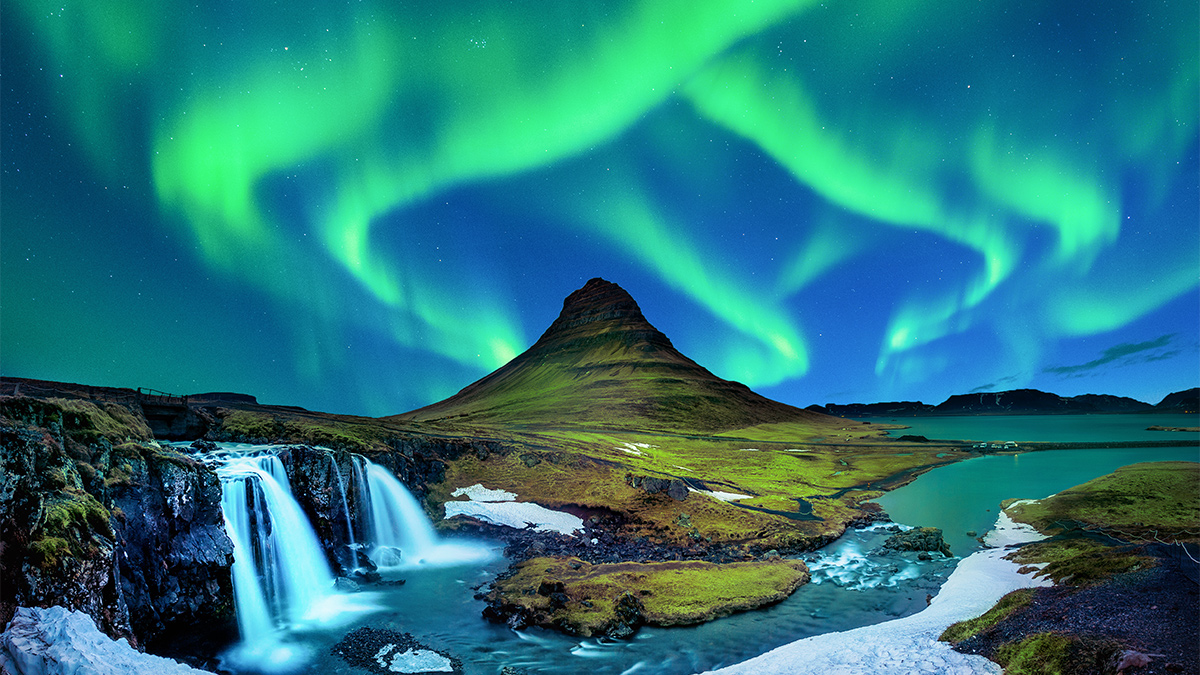Social Media
Örviri: The Fascinating Icelandic Whirlwind Phenomenon

In the land of fire and ice, Iceland, natural wonders are in no short supply. From its dramatic landscapes to its geothermal hot springs, the island nation offers a plethora of awe-inspiring sights. Among these natural phenomena is the lesser-known yet equally captivating örviri, a whirlwind phenomenon unique to Iceland. This article delves into the intriguing aspects of örviri, exploring its formation, cultural significance, and impact on the Icelandic environment.
Understanding Örviri
What is Örviri?
Örviri, derived from the Icelandic words for “whirl” (ör) and “weather” (veður), refers to a type of whirlwind or dust devil that occurs primarily in the highlands and volcanic regions of Iceland. These whirlwinds are similar to the more familiar tornadoes and dust devils found elsewhere in the world, but they possess distinct characteristics tied to Iceland’s unique geography and climate.
Formation of Örviri
The formation of örviri is largely influenced by Iceland’s volcanic activity and the interplay between hot and cold air masses. These whirlwinds typically form on clear, sunny days when the ground is heated by the sun, causing the air above it to warm up rapidly. When this warm air rises and encounters a layer of cooler air, it begins to rotate, creating a vertical column of spinning air.
In volcanic regions, the presence of geothermal heat can intensify this process. The heated ground, often covered in dark volcanic ash, absorbs and radiates heat more efficiently, providing the necessary conditions for örviri to form. Additionally, the rugged topography of Iceland can channel wind currents, further contributing to the formation and behavior of these whirlwinds.
The Unique Characteristics of Örviri
Size and Appearance
Örviri varies in size and intensity. They can range from small, short-lived whirlwinds a few meters in diameter to larger,. More powerful columns stretching up to several hundred meters high. Their visibility is often enhanced by the dust,. Ash, and debris they pick up from the ground, creating striking visual spectacles that can be seen from a distance.
Duration and Behavior
Unlike tornadoes, which can last for several minutes and cause significant damage, örviri are generally short-lived, often dissipating within a few minutes. However, their behavior can be unpredictable, with sudden changes in direction and intensity. This ephemeral nature adds to the mystique and allure of örviri, making them a captivating subject for both scientists and nature enthusiasts.
Cultural Significance of Örviri
Mythology and Folklore
In Icelandic mythology, natural phenomena like örviri have often been attributed to the actions of supernatural beings. Whirlwinds, in particular, were sometimes believed to be the manifestations of the Álfar (elves) or other mythical creatures. These beliefs have contributed to a rich tapestry of folklore surrounding örviri, with tales of these whirling dervishes being omens or signs from the spiritual world.
Modern-Day Interpretation
Today, örviri continues to captivate the imagination of locals and tourists alike. Photographers and filmmakers are particularly drawn to these whirlwinds, capturing their fleeting beauty in stunning visual records. Additionally, ör-=viri has become a symbol of Iceland’s wild and untamed nature, embodying the island’s dynamic and ever-changing environment.
Environmental Impact of Örviri
Erosion and Soil Movement
While örv-iri are not as destructive as tornadoes, they can still have a notable impact on the environment. The strong winds can cause soil erosion,. Especially in volcanic regions where the ground is covered with loose ash and pumice. This movement of soil and ash can alter the landscape over time, affecting plant growth and local ecosystems.
Interaction with Volcanic Activity
In areas with active geothermal and volcanic activity, örv-iri can interact with volcanic vents and fissures, potentially influencing the dispersion of volcanic ash and gases. Understanding these interactions is crucial for scientists studying volcanic activity and its broader environmental impacts.
Conclusion
Örviri, the Icelandic whirlwind phenomenon, is a testament to the island’s extraordinary natural landscape. From its formation rooted in volcanic activity to its. Cultural and environmental significance, örviri offers a unique glimpse into the dynamic forces shaping Iceland. As we continue to study and appreciate these natural wonders, örviri reminds us of the intricate and ever-changing relationship between the earth and its atmosphere, and the ongoing dance of natural forces that shape our world.

Social Media
What Does BBL Mean? [Tiktok]

When it comes to the TikTok FYP, there’s been a recent influx of videos about BBLs, but what precisely is the term? It stands for the Brazilian Butt Lift procedure, in which fat is removed in one portion of the anatomy and transferred to the glutes to increase their volume. BBL is an acronym. TikTok members may post before-and-after images of cosmetic procedures on their social media accounts.
Examples:
John: My wife just had BBL and she is looking saucy.
Marry: Real Mature.
How does bbl work?
The Brazilian butt lift procedure works by involving the use of liposuction to move fat from one portion of the body to the glutes. Implant insertion is less likely to cause infection when fat from the patient’s own body is utilized.
Bbl as a tiktok trend?
This app has always been a standout for its unique content and design. Other than that, there isn’t anything else like it in this program. It’s impossible to use these designs since they’re both too complicated and too basic simultaneously. The result is a separate niche for TikTok trends on the Internet. Everybody wants to try them out with their friends and family since they are so attractive. There are several tendencies on this app that aren’t easy to grasp. Business-building-leadership is an acronym for another of these terms, which goes by the abbreviation “bbl.”
The original meaning of this abbreviation was “come back later.” TikTok, on the other hand, does not use the word “video” in this way. For more than just being a trend-setter and following the crowd, people are getting these “bbl” surgeries in order to enhance their appearance and record their experiences on this short video-making application. Nothing could possibly go wrong with this procedure. Before going under the knife, all that has to be done is to come up with a decent reason.
Others do this to boost their self-esteem by changing their looks. Instead of thinking for themselves, they’re simply doing what everyone else is. If only for the sake of amusement, this craze should last longer than many other passing trends.
Summary
| WORD: | BBL |
|---|---|
| Definition: | Brazilian Butt Lift |
| Type: | Abbreviation |
What does the bbl effect do on TikTok?
There, it has a completely different connotation, which has caused millions of viewers to be perplexed. There’s a new phrase to add to the huge lexicon of the TikTok app. The abbreviation “bbl” refers to a treatment that is widely used in cosmetic surgery at the moment. It is an acronym for the method for which it is called, known as the “Brazilian Butt Lift.” In this procedure, fat is harvested from other places of the body and injected into the buttocks in order to increase the amount of fat found in the buttocks overall.
In order to achieve the appropriate posture and body look for the user, this device is used. For those who have had the operation, The BBL Effect pokes fun at how it unwittingly alters their neurochemistry for a new outlook on life.
More words that are similar in meaning:
Bbl face meaning tiktok
The BBL impact on TikTok may be found in someone who is 10,000 times better than you, to put it another way. To put it another way, they’re the kind of person that drinks through a straw, starting with their tongue. In order to avoid damaging their brand-new lashes, they will delicately wipe away their tears as they cry.
Social Media
Sudarse and Skin Health: How Sweating Can Impact Your Complexion

Welcome to the world of skincare where sweating, often viewed as a nuisance, can actually be your skin’s best friend. Yes, you heard it right! Sudarse – the act of sweating – plays a significant role in maintaining healthy and radiant skin. Get ready to uncover the surprising connection between sweating and skin health in this enlightening blog post.
The benefits of sweating for your skin
Sudarse is not just your body’s way of cooling down; it also offers some surprising benefits for your skin. When you sweat, your pores open up, helping to release trapped dirt and oil. This natural process can prevent breakouts and improve overall skin clarity.
Additionally, sweating can boost circulation, delivering essential nutrients and oxygen to the skin cells. This increased blood flow can give your complexion a healthy glow from within. Sweating also assists in flushing out toxins from the body, which can purify the skin and promote a clearer complexion.
Moreover, sweating has been found to stimulate collagen production, which helps maintain skin elasticity and firmness. The moisture produced during sweating can act as a natural moisturizer that hydrates the skin from the inside out.
Incorporating regular exercise into your routine that induces sweating can contribute to healthier-looking skin over time. So next time you break a sweat during a workout session or sauna visit, remember that it’s not just benefiting your body but also doing wonders for your skin!
The potential negative effects of excessive sweating on the skin
Excessive sweating can have some less-than-desirable effects on your skin. When sweat lingers on the skin for too long, it can mix with bacteria and clog pores, leading to breakouts and acne. The salt in sweat can also cause irritation and dryness, especially for those with sensitive skin.
Moreover, constant sweating can disrupt the natural balance of the skin’s pH levels, making it more prone to inflammation and redness. In some cases, excessive sweating may even exacerbate existing skin conditions like eczema or psoriasis.
It’s essential to address these negative impacts by maintaining good hygiene practices such as regular showering after sweaty activities and using gentle cleansers to remove sweat build-up without stripping the skin of its natural oils. Additionally, opting for breathable fabrics and staying hydrated can help regulate body temperature and reduce excessive sweating’s impact on your complexion.
Tips for managing sweat-related skincare concerns
Sweating Sudarse can be beneficial for your skin, but managing sweat-related skincare concerns is essential to maintain a healthy complexion. One tip is to cleanse your skin regularly to remove sweat, dirt, and bacteria that can clog pores and lead to breakouts. Opt for gentle cleansers that won’t strip your skin of its natural oils.
Using a toner after cleansing can help balance the skin’s pH levels and minimize pore size. Look for toners with ingredients like witch hazel or tea tree oil for their antibacterial properties. Hydration is key – drink plenty of water to keep your skin hydrated from within.
Choose lightweight, non-comedogenic moisturizers to prevent excess oil buildup on the skin’s surface. Exfoliate regularly with gentle scrubs or chemical exfoliants to slough off dead skin cells and unclog pores. Don’t forget sunscreen – protecting your skin from UV damage is crucial in maintaining overall skin health.
Natural remedies for sweaty skin
If you’re looking for natural remedies to help manage sweaty skin and maintain a healthy complexion, there are several options you can try.
One effective remedy is using witch hazel, a natural astringent that helps reduce sweating and tightens pores. Simply apply it to the skin with a cotton ball after cleansing.
Another option is incorporating apple cider vinegar into your skincare routine. Dilute it with water and use it as a toner to balance the skin’s pH levels and control excess sweat production.
Aloe vera gel is also known for its soothing properties and can help calm irritated skin caused by sweat. Apply a thin layer of pure aloe vera gel to the affected areas for relief.
Staying hydrated by drinking plenty of water throughout the day can also help regulate body temperature and reduce excessive sweating. Incorporating these natural remedies into your skincare regimen may help alleviate sweaty skin concerns.
Conclusion
It is evident that sweating plays a significant role in skin health. While sweating Sudarse can have numerous benefits for your complexion, such as detoxifying the skin and promoting circulation, excessive sweating can lead to issues like acne and irritation. By following the tips provided and trying out natural remedies, you can effectively manage sweat-related skincare concerns and maintain healthy-looking skin. Remember to embrace the sweat while also taking care of your skin to achieve a glowing complexion. Stay hydrated, keep your skincare routine consistent, and listen to what your body needs to strike a balance between staying active and caring for your skin.
Social Media
The Power of Numbers: How 646-569-9288 can impact your life

Numbers have always played a fascinating role in our lives, guiding us through decisions big and small. But what if I told you that one particular number, 646-569-9288, holds the power to impact your life in ways you never imagined? Today, we delve into the mysterious world of numbers and uncover the hidden significance behind this enigmatic sequence. Get ready to unlock the secrets that lie within 646-569-9288 and discover how it can lead you towards a path of positive transformation.
Understanding the significance of numbers
Numbers are more than just symbols on a page; they carry energy and meaning that can shape our experiences. Whether it’s the date of your birth, the time on the clock, or even your phone number, numbers hold a powerful influence over our lives. Each digit has its own vibration and significance, guiding us through life’s twists and turns.
Numerology is the study of these hidden meanings in numbers, offering insights into our personalities, relationships, and destinies. By understanding the significance of numbers like 646-569-9288, we can tap into their transformative power and align ourselves with positive energies.
Every number has a story to tell, if we’re willing to listen. Embrace the magic of numbers and open yourself up to a world of infinite possibilities waiting to be explored.
The history and meaning behind the number 646-569-9288
Have you ever wondered about the hidden meanings behind certain numbers? The number 646-569-9288 carries a unique history and symbolism that may surprise you. Each digit in this sequence holds its significance, creating a powerful combination when they come together.
In numerology, each number is believed to possess its energy and vibration. When we delve into the history of 646-569-9288, we uncover layers of meaning that can offer insights into our lives. This particular number sequence is said to symbolize strength, harmony, abundance, and positive transformation.
By understanding the history and meaning behind 646-569-9288, we can tap into its potential to bring positivity and change into our lives. Whether it’s through manifestation techniques or simply being more mindful of the numbers we encounter daily, incorporating this powerful sequence can have a profound impact on our experiences.
Personal experiences with numbers and their impact
Numbers have always played a significant role in my life, guiding me through both the ordinary and extraordinary moments. Whether it’s seeing repetitive numbers on the clock or noticing patterns in phone numbers, I can’t help but feel a sense of connection to the universe.
I remember a time when the number 646-569-9288 kept appearing in different contexts – from receipts to license plates. Each time I encountered this number sequence, it felt like a gentle nudge from the universe, urging me to pay attention and stay open to new possibilities.
These personal experiences with numbers have taught me to trust my intuition and embrace synchronicities. By staying attuned to these subtle messages, I’ve been able to make important decisions with clarity and confidence.
The impact of numbers may seem subtle at first glance, but their influence can be profound if we choose to listen and learn from them.
How 646-569-9288 can bring positive change into your life
Have you ever wondered about the power that numbers hold in our lives? Each number carries a unique energy and meaning, influencing our experiences in ways we may not even realize. One such number worth exploring is 646-569-9288.
This specific sequence of numbers, 646-569-9288, has a vibrational frequency that can bring positive changes into your life. When you start noticing this number appearing repeatedly, pay attention to the thoughts and feelings you have at that moment – they might be guiding you towards something significant.
By embracing the presence of 646-569-9288 in your life, you open yourself up to new opportunities and growth. This number could serve as a reminder to stay optimistic and focused on your goals, leading you towards a path of success and fulfillment.
Allow yourself to be receptive to the subtle messages that 646-569-9288 conveys. Embrace its energy with an open heart and mind, trusting that it can guide you towards positive transformations and blessings.
Using numerology to unlock hidden meanings in numbers
Numbers have always held a mysterious allure, whispering hidden meanings to those who dare to listen. And in the realm of numerology, these numbers take on a whole new level of significance. From birth dates to phone numbers, each number carries its own unique vibration and energy.
Numerology is like a secret code that can unlock the mysteries of our lives, revealing insights into our personalities, strengths, and challenges. By analyzing the numerical values associated with letters in names or dates of birth, numerologists can uncover hidden truths about an individual’s life path and purpose.
Through the lens of numerology, every number tells a story – a tale woven with threads of destiny and opportunity. Whether it’s decoding your personal year number or exploring the meaning behind a specific sequence like 646-569-9288, numerology offers a roadmap to navigate the twists and turns of life with clarity and insight.
So next time you encounter a series of numbers that catches your eye, consider delving into the ancient wisdom of numerology to uncover its hidden messages waiting to be revealed.
Other numbers to pay attention to in your daily life
Have you ever noticed how certain numbers seem to pop up in your life more frequently than others? Pay attention to these recurring numbers, as they may hold special significance or messages for you. Whether it’s a specific date, a time on the clock, or even the number of likes on a social media post, these numerical patterns could be trying to communicate something important.
Numbers like 1111 or 333 are often associated with spiritual awakening and alignment. Seeing these repetitive sequences can serve as gentle reminders to stay connected with your higher self and trust the path you’re on. Similarly, numbers such as 777 or 888 are believed to bring luck and abundance into your life.
Don’t dismiss the power of numerical synchronicities; they might be guiding you towards new opportunities or encouraging you to make positive changes. Stay open-minded and receptive to the messages that numbers can convey in your daily life.
Conclusion
In a world filled with numbers that hold various meanings and significance,. It’s fascinating to explore how 646-569-9288 can impact our lives. Whether through personal experiences, historical contexts, or the mystical realm of numerology,. Numbers have the power to guide us towards positive change and growth.
As we continue on our journey through life. Let’s embrace the power of numbers like 646-569-9288 and remain open to the hidden messages they may hold for us. Pay attention to the signs around you, trust in the universe’s guidance, and allow these numerical vibrations to lead you towards a brighter future filled with abundance and positivity.
Remember, numbers are not just symbols; they are cosmic forces waiting to be deciphered. So next time you come across 646-569-9288 or any other number that catches your eye,. ake a moment to reflect on its meaning and see how it resonates with your own life journey.
Embrace the magic of numbers, harness their energy for personal,. Transformation, and let them pave the way for new opportunities and blessings. The power of 646-569-9288 is within reach – all you have to do is believe in its potential to shape your reality.
-

 Business2 months ago
Business2 months agoWhat does Incumbent mean in business?
-

 Text2 months ago
Text2 months agoPH
-

 Text2 months ago
Text2 months agoWhat does smh mean in text?
-

 Text2 months ago
Text2 months agoKN
-

 News1 month ago
News1 month agoDiscover MyLawyer360: Your One-Stop Legal Assistance Hub
-

 Business1 month ago
Business1 month agoLessInvest.com Crypto: Your Gateway to Smarter Investments
-

 sports1 month ago
sports1 month agoThe Versatile Talent of ben foster: A Deep Dive into His Career
-

 Health1 month ago
Health1 month agoThe Comprehensive Guide to Mega-Personal.net Health Archives